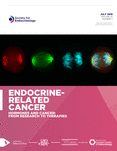The evolving clinical, genetic and therapeutic landscape of multiple endocrine neoplasia type 2
- 1Division of Cancer Biology and Genetics, Cancer Research Institute, and Department of Pathology and Molecular Medicine, Queen’s University, Kingston, Ontario, Canada
- 2Department of General-, Visceral- and Transplantations Surgery, Division of Endocrine Surgery, Medical Faculty, University of Duisburg-Essen, Duisburg, Germany
- Correspondence should be addressed to L M Mulligan: mulligal{at}queensu.ca
-
Figure 2
MEN2 mutations in the RET receptor tyrosine kinase. Schematic diagram showing locations of the common RET mutations identified in MEN2 patients. The two mutations associated with MEN2B are indicated in red. Two sequence variants suggested to act as modifiers, either affecting severity of other RET mutations or as risk-associated alleles in other cancers, are indicted in blue. RET protein domains indicated are CLD, cadherin-like domains; CRD, cysteine-rich domain; KD, kinase domain; TM, transmembrane domain.
- © 2018 Society for Endocrinology












